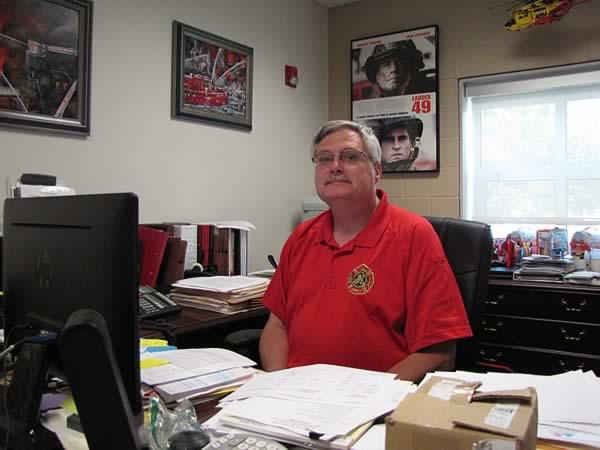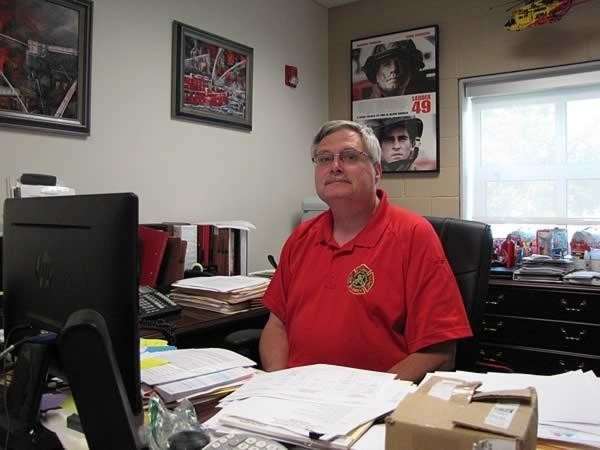
Park Forest, IL-(ENEWSPF)- After a life of service to the people of Park Forest, Fire Chief Bruce Ziegle will retire October 20.
eNews Park Forest sat down with the Chief as he reflected on his decades in the Village, beginning when he was a sophomore in high school. He earned his first paycheck from Recreation and Parks in 1975 working with the roller-skating program.
Chief Ziegle attended Westwood Junior High School and Rich East High School, beginning his work with the Park Forest Fire Department after he turned 18: February 2, 1977. And that became his life’s work.
He spoke with ENEWSPF about the challenges and the changes he’s seen in the PFFD, and other department’s he worked for through those years. A native Park Forester, he shares some of the high points (saving children, successful paramedic calls), and some that gave him more pause. An accident east of Western Avenue on Sauk Trail, for example. Or that time a steam roller ran over its driver in Matteson.
That happened.
And it was Firefighter/Paramedic Bruce Ziegle who was tasked with communicating with the hospital ER, trying to explain what had happened to the man who, after the accident, was only two inches thick.
Our interview with Chief Ziegle:
eNews Park Forest: So, what is your official [retirement] date?
Fire Chief Bruce Ziegle: My last day as a full-time employee of this department will be October 20th, 2017.
eNews Park Forest: Are you go full retirement, are you going to stick around a little bit?
Fire Chief Bruce Ziegle: I promised them I would stick around and help them with some special activities, mostly grants and grant administration and then depending on wherever they might find me useful. I am not planning on going anywhere soon. I have some free time to dedicate to them but I don’t want to be coming here 40 hours a week anymore.
eNews Park Forest: Its October?
Fire Chief Bruce Ziegle: October 20th.
eNews Park Forest: How long will you have been in public service at that point?
Fire Chief Bruce Ziegle: How do you want to define public service? Working for the village?
eNews Park Forest: Let’s go with the village first.
Fire Chief Bruce Ziegle: I’ve working for the Village, where I actually got a pay check, 1975. I worked for Parks and Recreation in 1975 mostly doing their roller-skating program.
eNews Park Forest: Where was that?
Fire Chief Bruce Ziegle: They used to do it at the recreation center.
eNews Park Forest: Really?
Fire Chief Bruce Ziegle: On the gymnasium floor. Originally, I started out as a volunteer skate guard. Before that, when I graduated in to high school, I did a couple years of volunteer skate guard and then as the adult who was overseeing. The program changed a little bit, my role kept growing and growing, and then they started paying me a little bit more and a little bit more, until, by around 1975, I was actually running the program for them.
eNews Park Forest: How old were you in ’75?
Fire Chief Bruce Ziegle: I was a sophomore in high school, through my sophomore and junior year.
eNews Park Forest: And you have been with the Village pretty much ever since?
Fire Chief Bruce Ziegle: Yes. I worked through various Parks and Recreation things for them until I turned 18, and the after I turned 18, I worked playground programs they did back then in the schools. I worked open gym programs for different age groups. As I got older I actually did some work with the men’s basketball and the volleyball leagues and things like that.
At one point, I was the emergency go-to guy of some program. Couldn’t get access to their building or whatever, I had keys to everything and ran around and could sub for pretty much anybody and just open up the building and get it set up type program not as an instructor necessarily.
eNews Park Forest: So, you are pretty much a lifer.
Fire Chief Bruce Ziegle: I’ve been here, well, about 43, 44 years all together of my 58 years total. I was like 14 or 15 something like that.
eNews Park Forest: So, you are 58 now?
Fire Chief Bruce Ziegle: I am 58.
eNews Park Forest: When did you move in fire services?
Fire Chief Bruce Ziegle: I had to be 18, so in my senior year of high school, a couple of days after my 18th birthday, I started as a member of the paid on-call [POC], February 2nd, 1977.
eNews Park Forest: February 2nd, 1977. I was waiting to graduate 8th grade.
Fire Chief Bruce Ziegle: I was still in high school. I was a senior in high school and started on the Fire Department and then it took five or six weeks until we had Friday night training with just this group of new paid on-calls. After about five or six weeks, “Here is your gear you are going out there”.
eNews Park Forest: Now how did that work back then, how did you get a call?
Fire Chief Bruce Ziegle: They had pagers. We had pager notifications. There were still some people who had the old telephone notifications as well, but that was before my time, so I never had any of that which would ring your phone bells, they would put a special set of phone bells connected to your phone, and the dispatcher would push a button, and it would ring bells in your house.
The problem was when people moved out and were no longer paid on-call, sometimes those were still connected, and people would be like, “How come these bells are always ringing in my house?” Come to find out there used to be a paid on-call fireman there. Either he still lived there and didn’t mind like, “Oh I know something is going on in town.” That was a little bit before my time. They had just really started moving in to radio pagers at that point in time.

eNews Park Forest: So, you saw the department at that time, of course you were in the other building, and you have seen this Village grow then?
Fire Chief Bruce Ziegle: Well, it was pretty much grown at that point in time. The department was probably close to its largest it had ever been mostly because of the size of the paid on-call. The career department hasn’t changed much in size. The paid on-call there were about 55 members at that time. There were so many that I didn’t have a place to hang my gear in the station. The rail to go down to the basement stairs that is where my gear sat for a couple of months until they thinned out and there was enough room for us to move up on to a rack.
eNews Park Forest: When did you move from paid on-call?
Fire Chief Bruce Ziegle: When I was 21 I was hired by the University Park Fire Department full-time. I remained a member of the paid on-call here in Park Forest. I worked there for a little over four years, then I moved to the Matteson Fire Department full-time. University Park at that time was an all daytime, the crew people were all day time so I worked 10 hour days.
At Matteson, myself and my partner and one of the other two guys who worked in University Park moved to Matteson. We both moved at the same time and worked five 10 hour days, but there was light at the end of the tunnel. There would be a short period of time, and then we would go to working shift work. About nine months into Matteson, Park Forest came calling, Chief Morrissey, and asked if I was interested in moving to the Park Forest Department full-time. I said, “Certainly.”
At that time, though, I was very happy in Matteson. Most of the lieutenants and people in the higher up positions were just barely older than I was. So, they had a number of years they were going to be in their current job there, so the chance of potential move up was more likely in Park Forest, which had a lot more senior guys who were going to retire.
So, after nine months, I moved to Park Forest. I went directly to shift March 23rd, 1986, I think, and from then on, I have been a career member.
eNews Park Forest: What are some of the biggest changes you have seen?
Fire Chief Bruce Ziegle: The biggest changes in the Fire Service since I started?
eNews Park Forest: Yes.
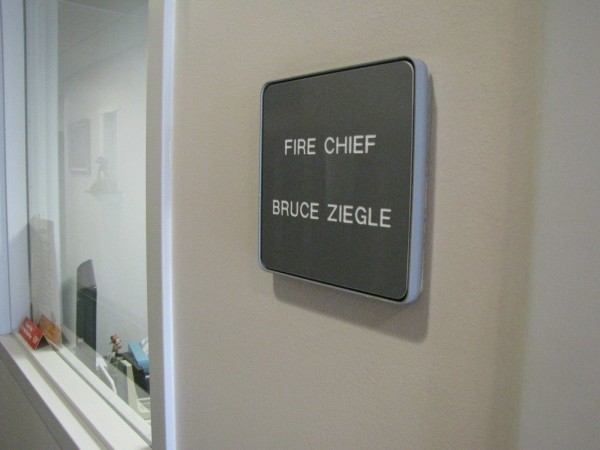
Fire Chief Bruce Ziegle: Technology and the use of it. When I came on board everybody got a pager. There were very few portable radios to be had. Only the officer in charge of the crew on a particular vehicle would have a portable radio. Now, everybody who rides on our vehicles carries one for safety purposes mostly. Thermal imagers didn’t exist. There were probably some in the military back then, but that technology hadn’t been developed for the fire service. So, nobody was running around with a camera that could see through smoke and all that.
eNews Park Forest: I didn’t even know we had them.
Fire Chief Bruce Ziegle: Smoke detectors were not very common in homes. They were just coming into practice, and we had a huge campaign back in the late ’70s to get smoke detectors in every house in town. We had a giant map on the back on the apparatus floor, and every time somebody would go over and check and find another house with a smoke detector in, we would put another pin in this map. So, the goal was to have pins in every home in the map, which we eventually did because sometime thereafter it became pretty much a state-wide and national standard to have smoke detectors. We were a little ahead of that curve.
I would say the EMS sector and how it has expanded over time. When I first became a paramedic, short of somebody in a complete cardiac arrest, we didn’t get to do a whole lot. We got to start an IV, take a set of vitals, transport them to the hospital. We didn’t get to do Johnny and Roy and give all kinds of medication unless they were in a complete cardiac arrest, then we gave a lot of medications and things like that. But over time, that attitude has changed: more reliance on the pre-hospital people to at least start the treatment out for people and get them headed on the right path rather than wait until we get to the hospital.
We would carry the same medication the hospital had in our drug box and we would get to the hospital, and the minute we walked in the door they would give them the medication that we could have given them in the field, and we are like, “Well why didn’t you order us to give that in the field?” and they are like, “We are not comfortable with that.” So, over the years our standing medical orders have changed to allow us to do a lot more in the field to get the patient on the right path faster and hopefully intervene in their problem before it becomes too serious, and then they become that cardiac arrest or difficulty breathing.
Some of the best things, Albuterol is a very simple drug that people now get in their inhalers and things like that, we never carried that for a long time and then we started carrying that and giving it to severe asthmatics who a lot of times they would not be breathing by the time we got to the hospital. Well, now we are able to give them that, and now we have added the CPAP mask to really get it in to their system, and we rarely have to do anything where we intubate those types of asthma and difficulty-breathing-type patients in that area which is a huge step.
We used to be scurrying to get them in, racing to get them in, because their whole airway was closing off. Now we give them some Albuterol and we have had them– the people were on the floor trying what they think is going to suck air from off the floor and it is not doing them any good to where by the time we get them to the hospital the doctor examines them they do a few quick tests and they are out of the hospital and on their way home. Where before they might spend days in the ICU and things like that.
We had hazardous materials. When I first came in to the Fire Service, hazardous materials was very new to the Fire Service, and, basically, they gave it to the Fire Service because nobody else wanted to do it. So, the Fire Service took it on and then expanded it from an education and training standpoint. The first hazmat training I got was about four hours, “Okay you are ready to go.” Now, we send guys to school for weeks at a time to learn how to deal with it and properly protect themselves as they deal with hazardous materials.
Technical rescue, again, something a lot of fire departments did but they weren’t truly trained in. The big city fire departments, they had collapse teams and things like that. Now all across the suburbs there are people trained in that, again, to get things started while you get more and more people together to deal with the problems. Items like the Plainfield tornado, where it would have taken a long time to get resources out.
There are still some areas where that is [happening] like the Deep Tunnel Project, because it is considered essentially a tunnel, a mine, you have to be specially trained to go in to the Deep Tunnel Project. We have very few people out here that are trained to go in to that because it is very expensive training. The City of Chicago, because that is what the Deep Tunnel is there for, has a lot of trained people. So, they are actually the first response technical team to the Deep Tunnel, but it may take them four hours to get there and that presents a problem.
So, we had some people trained through Thornton and Lansing, some of those people had access to areas of the Deep Tunnel, to get people in there. It is about a week-long training class, highly specialized and unusual training. You have to spend the better part of one day in special breathing apparatus and you go to class all day long and you wear breathing apparatus because you have to spend so many hours in it, because it is a much longer term breathing apparatus than we are used to.
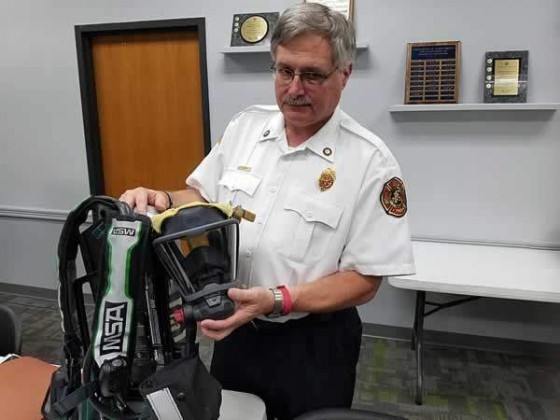
Again, equipment as it has changed in the service. When I first came in to the Fire Service, we had some breathing apparatus, but not enough for everybody and you rarely used it. As the furniture in the homes changed and the whole makeup of the smoke changed it became to be used more and more. So now we have enough SCBAs, pretty much everybody that comes to the scene can have one on of our people.
When I started at times we would have six or eight people on an engine and only two people would have access to a self-contained breathing apparatus. But in those days, you didn’t necessarily need it nearly as bad, and of course we didn’t know the problems that were being created over that time. There was no concern of cancer or exposure to certain hazardous materials or other things. All those things didn’t come about more so until after basically 9/11 and they started paying a little bit more attention to that.
eNews Park Forest: One of the things that you really took the lead in that I saw as Deputy Chief and then Chief was grant applications and that has been a whole world.
Fire Chief Bruce Ziegle: That has been a huge boost to the department. We have gotten almost a million dollars in grant funds since these programs have started. We probably applied for 10 million dollars worth, but we have gotten close to a million dollars in grant funds, and that was through the support of chiefs at the time who were willing to let me go out and get some training in that area, and then to get involved in being a peer reviewer in that program so I could see more of the nuts and bolts of the program, see how to improve our chances of receiving grants Since I have been doing that, we have had a lot more success in receiving grants.
We were one of the few people, there are people who hire professional grant writers and things like that, we are one of the few people who do our own grants and have gotten grants across the spectrum of a variety of programs. Pretty much I would say every public program that we have had a chance to dip our toes into we have at least been successful in one way shape or form. Some of the private grants, it’s a little harder. We’ve been working on stuff like trying to apply the fire house subs and some of these other foundations who deal a little differently in the whole grant aspect, but we have been very successful in the public grants. We have got them from the Department of Public Health, the Office of State Fire Marshall, and then a myriad of ones from the Assistance to Firefighter Grant Programs.
As a matter of fact, we are waiting on our new trailer which is supposed to be done this month, public education trailer that more than 90% of will be paid for by a Federal grant. It replaces our one that is seventeen years old now and it is starting to show its wear and tear.
eNews Park Forest: I heard something about that. So that is going to be replaced, you are going to be able to start self-contained fires?
Fire Chief Bruce Ziegle: Yes, it will have a sprinkler demonstration area in it to help promote home sprinklers, and then it will have an education area as well.So, we can do multiverse type training plus any time we want to do a sprinkler demonstration in a controlled atmosphere. That was one of the key requirements to get a grant for a new trailer was that it had some kind of sprinkler element involved in it. So, we made sure that we included that.
We just replaced all our breathing apparatus which was the second time we had gotten it under a grant program. We would as a department or a Village never of been able to do it on our own, replace all our breathing apparatus at the same time. As a matter of fact, when I came on we had two different brands of breathing apparatus which were incompatible with each other, and the big thing is making sure they all remain compatible with each other, so if you move from one vehicle to another you don’t have to change the way you learn.
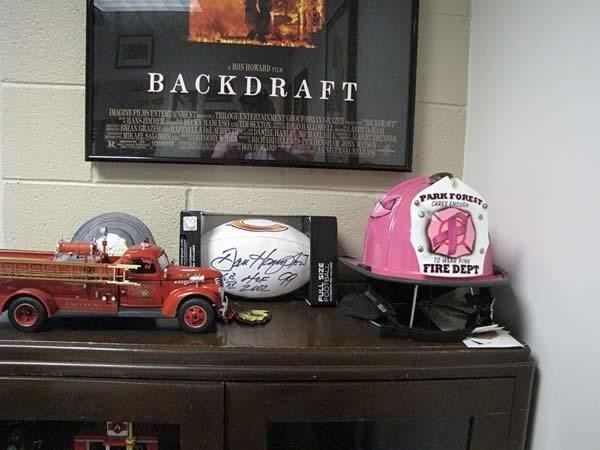
eNews Park Forest: One of the things that I have always wondered and I think it is since I moved out here, but the private companies doing ambulance calls, and I think there is a benefit to having public service employees perform that task.
Fire Chief Bruce Ziegle: Well, there is the multiskilled though, now that they can do whatever task comes up on them. They can do EMS they can fire they can do rescue. If you are using a private ambulance service — right now a lot of the communities around here that have no ambulance service and contract out, they have a private company run their service not from their fire station, but you just contract your service. Sauk Village, Ford Heights, those folks, they are lucky if the private ambulance company that is protecting [them] has one or two ambulances in their area.
One figure I heard, they had five ambulances covering thirteen communities at one point in time, because that is how many people they had on duty and the units they had available. Now, there is that contracting purely with a private service to deal with everything, and some departments have gone that way. Harvey used to be their own service and went that way to have a private company do their service. It was a budget-driven decision, a staffing-driven decision, but they also used to have close to thirty people on duty and now they are down to having ten or twelve on duty at a time.
Or, you can contract somebody to come in an either just run your ambulance calls, or help you on the fire side. Communities like South Chicago Heights, Crete, Crete Township, Steger, they all contract for an individual to be in their station 24 hours a day and then they provided a second person to run with that individual to provide their service. Or you can contract where they will work help you with your fire side, and items like, that which most people do in this area just because you can’t specialize that much just because you can’t afford it. If they are not being able to help you with whatever call you have, you don’t want them standing there twiddling their thumbs when something is burning down if they could help you out.
There are a lot of companies out there that are doing that and it bounces around. Tinley Park is a huge example of a large community that relies on a private service but they have a very specialized contract. When they contract with a service they require them to have “X” number of ambulances in their town. Most recently, in their last contract, said not only have you got to have them in our town, you are going to put them in our fire stations, which was a first. Before that, they would go find a parking lot and sit somewhere in town. Now they put them in their fire stations, they act and respond with those crews as necessary, or on other things they want. They went from having three or four ambulances, I think they have six now in Tinley Park, but they run a lot of EMS calls, and it is a private service.
Most of the private services want to get involved in it because there is money to be made in it. If a municipality has somebody doing that, then they are giving up that potential revenue to that organization in order to do that. In a lot of cases, not only are they giving up that revenue, but they are paying them as well. Most of the places, let’s say Sauk Village, where they pay them a flat fee a year to be in their program and the company gets to take all the ambulance revenue in the process, which is quite interesting.
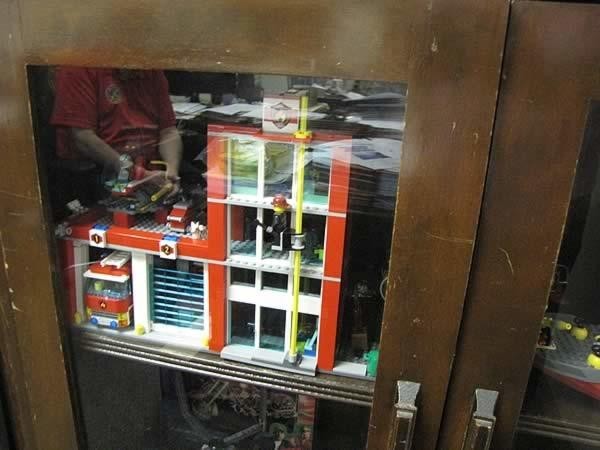
eNews Park Forest: I still don’t understand how that benefits anyone.
One of the things that I noticed most notably was a rise in morale in the Fire Department.
Fire Chief Bruce Ziegle: I think it has to do with us getting a lot of new young people in here, actually a large group of firefighters and nearing retirement. They are more looking at that goal and they have kind of “petered-out” on their ability to be friendly to the public (chuckles) on a repeated basis, especially as, even though our population is going down, our number of calls continue to go up, which is something that shouldn’t be happening, but it does. Every time I explain that to the board and they are like, “Well why does this happen?” and I am like, “Well, its demographic-driven. You get people who are high service uses. That police department has seen a lot of activity even though our population goes down. You have got your people, who, instead of dealing with problems or dealing with issues, they call the ambulance”.
When I was a young child in this town, I broke my hand playing hockey. I broke all the bones across my hand playing hockey. It happened to be Halloween and I played hockey and I blocked a shot and broke all the bones across my hand. I took all my equipment, I walked home, found my mother. She drove me to the doctor’s office. They put it in a temporary splint. We went back the next day and the set it. No ambulance was every involved.
Nowadays, somebody dislocates a finger and then they are calling an ambulance. I dislocated a finger in high school and never called an ambulance. I walked in and the nurse who happened to be married to one of the fireman, back in those days she was married to a man who was a fireman here. She was kind of aghast to see my finger swinging down, and I am like, “It is no big deal. I just need somebody to pop it back in for me.” And no ambulance involved there.
Today, people don’t know what to do, or because they don’t have health insurance or they have limited health insurance, they figure their best bet is to go to the emergency room and that becomes their medical doctor. Where, in the good old days, people call up their family doctor and go see them or whatever. There were times where people called the ambulance, but it was highly infrequent. You would not see it in your neighborhood very often.
eNews Park Forest: It was more emergent.
Fire Chief Bruce Ziegle: Yes, the definition of emergency has changed over time, and we find that we get a lot of calls because people just don’t know what to do. Either they are not familiar with the type of property. They came out of the city and lived in apartments their whole life and now they are out here. We had a woman a few years ago who we had a call of a woman lying in the parkway over here at Forest [Boulevard] and Main Street. So, we and the police we both responded, and the lady said, “Oh, yeah, there is some kind of terrible gas.” She lived in the rentals over there. “There’s some kind of terrible gas in my apartment, I don’t know where it is coming from.” So we let the ambulance take care of the woman and we went go over to find out.
We go in to her apartment we can’t find anything. Go back to talk to her she is like, “Yeah, yeah. I thought it was up there. I went down, I opened the basement window, I tried to air the apartment, it only got worse.” We came to find out, we go back again, and the rental maintenance guy is there and he goes, “Was there a problem in the apartment?” and I go, “Yeah, the lady is complaining of a noxious smell.” He goes, “Well, I took two skunks out of the window well a little while ago.” So, when she opened the window, all she did was create a better path for the skunk smell, and she had no idea what that was.
You would be surprised how many calls we get where people are calling in and there is a gas smell or a noxious odor, and you walk in and go, “That is a skunk,” and things like that because they are not familiar. They have lived in the city all their lives and relocated out here. They are used to the level of services the City of Chicago provided, which interestingly enough, we did have people who came out here many years ago, when we were still in the other building. It is a Sunday afternoon, and we are just sitting around watching TV, watching a ball game or something, and one of our paid on-call members comes in, and he sits down he goes, “Dang, you guys back from that call already?” and we went, “What call?” he goes, “Oh yeah some ambulance call over on Chestnut”.
Well there had been a failure in a system that brought the dispatch signal over to the fire station. So, the dispatcher had dispatched us but it never went anyone. So, we called over there, we raced to the scene. There was probably ten or twelve minutes until we got on the scene, which for us is an extremely long time, and those people are like, “Boy you got here fast.” And we are like, “You used to live in the city, didn’t you?” and they went, “Yeah. We wouldn’t see an ambulance for a half hour to an hour.” “Well, normally we would be here a lot faster than this,” we’d say.
But these are people who will call for more things. The rise in the senior population has a little bit to do with that, especially single seniors still in their original homes. You will see a lot of, especially older women, who don’t want to leave the family home because all they have got to do is pay the taxes and utilities to stay there, and they run in to a problem. We have had pilot light issues, and water heater issues, and things like that where they just don’t know what to do, and they don’t have anybody to call, so they call us and we go over and try and take care of their problem as much as we can.
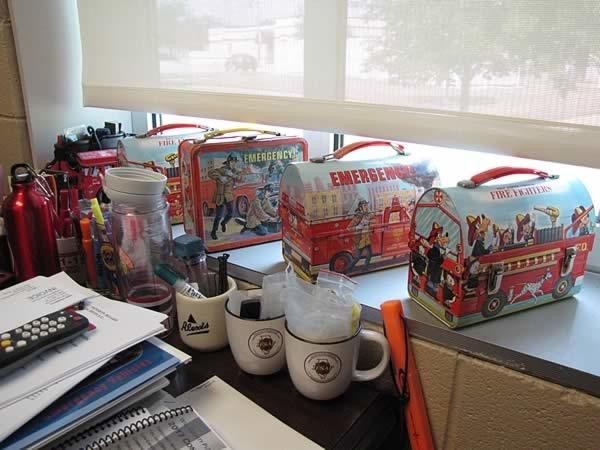
eNews Park Forest: Is there any one call or two calls that stand out?
Fire Chief Bruce Ziegle: Well, anything that involves a fatality, of course, tend to stand out. Large fires tend to stand out. They all kind of get lost in the shuffle. During most of the time I was a career guy here, even up until just a few years ago, I was also the assistant Chief in University Park at the same time. So, a lot of those things kind of blend together and you are like, “What town was that?”
We were just talking about one earlier, when one of the new people was asking me about how my career progressed, and I said, “Yeah, in the nine months that I worked for Matteson, I worked on a lot of strange calls,” because there was a lot of construction going on, they were rebuilding Route 30 at the time. I said, “There were a lot of strange calls but in all of those, including some that you would swear people would be dead, only one time was anybody ever dead. Well, nobody ever died because of us, nobody ever died with us.” “Wait a minute, you had that guy that was run over by the steam roller.” I go, “Well, yeah, true, but he was already dead before we got there, so we didn’t have anything to do with that.”
eNews Park Forest: Run over by a steam roller?
Fire Chief Bruce Ziegle: Right by where their new station is, they were doing the transition there between– it wasn’t their fire station at the time it was a property there and a funeral home. They were working the transition. As they were working on one side of Route 30, this guy was the operator of the roller, and he is going back and forth, and one time as he leans over, he is grabbing the steering wheel, he is looking where he is going and he is adjusting the throttles. The steering wheels on those [steam rollers] snap in and snap off for transport. Well, this one snapped off [as he was leaning], and he slipped, and he fell, and he grabbed the throttle handles. It dragged him all– according to witnesses at least–it dragged him all the way across the street toward what is the Olympia Fields parking lot, which was empty at the time because of the construction.
When he hit the curb on the other side it knocked him loose, and it ran him over. The most surprising thing about that is there wasn’t any [bodily] fluid anywhere. It probably all went down into the ground. He was in a low depression area that had rock in it, and we thought there should be–you think cartoon where everybody splatters–and there is no fluid, and there wasn’t any.
But he was about two inches thick.
I got the special task of explaining that to the hospital on the radio, about what was going on. We are like, “We have got a 42-year-old man,” and they probably weren’t paying a lot of attention. “He is in his 40’s, this 47-year-old man, he [was] run over by a roller. He has got massive injuries,” and they are like, “Well can you expand on the type of injuries?” And, finally I am like, “Well, we are of the opinion that 75% of the bones in his body are probably broke, and that he is two inches thick.” And then she kind of went, “Come again?”
“He is about two inches thick. Everything from foot to the head is about that”.
Those are the things that you remember.
Cases where we have pulled children out of fires, and, in most cases, we have been lucky. There has not been a lot of deaths involved in that, occasionally we have those problems. Especially infants, those are the ones that tend to bother you a little bit more. Luckily, in this town, we are very quick to respond. So, in most cases, if they stood a chance, we can rescue them. When it happens that we can’t rescue them, it’s because they didn’t stand a chance to begin with.
Most recently we had one on Winnebago [Street] that was a similar case. When you are in the fire room that is heavily involved, and your ability to exit is compromised by something you have done throughout the evening, there is not much we can do for you unfortunately. And that usually hits people pretty hard. And every time you see somebody die for any reason, it is hard.

We really love when we have things go the other way. I remember Easter Sunday, many years ago, we had– the mother she was preparing Easter Sunday dinner for her big family, and she went down and had a heart attack. We were able to revive her, and probably a month later she is at home, and the family is all coming up here and they are bringing us food and things like that because, “You saved our mom.” Those are the great ones.
Early on in my career, I went to paramedic school very early, so I was a very young paramedic, I was seeing people I went to high school with, or the parents of people I went to high school with. As a matter of fact one of my best friends, his father died of a heart attack. Thankfully, I was not directly involved in that. That kind of upset me a little bit, because, I was like, “If I had a chance, maybe I could have done something for your father.” Those type of things, where you think you can do something for somebody, kind of sets you back. And when you are able to do something, the allergic reaction, things like that, where you can step in and make a drastic change in their condition, that gives you the real positive feeling.
The change, I think, in morale comes from, everybody here is a paramedic. There are a lot of EMS calls, and, over time, they see so many people that they get that kind of gruff exterior on now because they have just seen too much. Thankfully, right now, in our system, the farther you get up in the chain in seniority, the less time you put on the ambulance. It puts a little more stress on the new people, but, eventually, they are going to get to a position where they are not running so many calls.
I’ve had people die in car accidents, and you are cutting them out. But, again, people we save cutting them out of cars. We had a guy Sauk Trail east of Western [Avenue] that, him and his buddy, it was early New Year’s morning, and him and his buddy left the roadway, and their van was up in the air against a tree, and they were fine until they got out. When they got on to the ground, they shifted the weight of the car, and it flipped over and landed on top of them. One of those guys was fine, the other one not so fine.
Sauk Trail-east-of-Western accidents were some of the most horrific car accidents I have ever seen.
There was the lady who worked at the bank when it might have still been the Bank of Park Forest, when the two guys were racing coming westbound, and one of them crossed over and hit her so hard that the engine for one car was like 500 feet away from the car itself, because it just disintegrated and threw things away. This woman was a complete innocent, she was just driving from one place to another, and got hit. That is sometimes what makes you really feel for these people is that it wasn’t anything they did. It was generally the action of somebody else that causes it to be such a bad item in their life at that time.
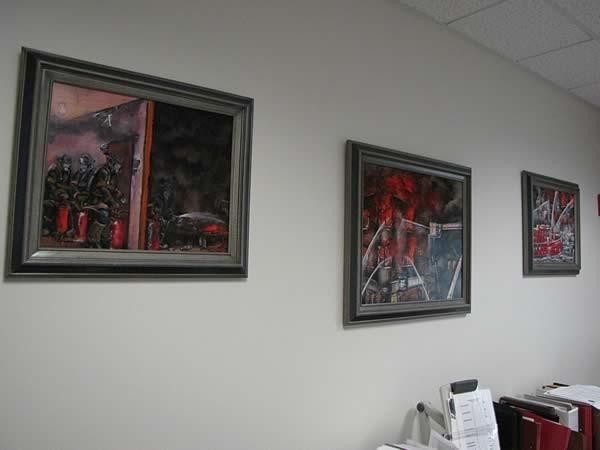
eNews Park Forest: Any closing thoughts? Anything you would like to say to the people?
Fire Chief Bruce Ziegle: It has been my pleasure to serve the residents of Park Forest. I have had a wonderful career. I wouldn’t have done it any other way. Well, maybe that is not true. I might have decided I didn’t want to be chief because it was always much more fun on the shift side, but I love serving the people of Park Forest. I love being able to do for them whatever we can and hopefully make a difference in their situation in a positive light.
That is what I got in to this for. You come in to your first interview to get the job and they ask, “Well why do you want to come here?” Everyone says, “I want to help people,” and for some people, that is the truth, and for some people, they know that is the answer that they are supposed to give. For me, it was all about wanting to help the people here, and basically they are like, “What is your long-term goal?” “Well, I would like to be the Chief.” I took my first fire test shortly after I got hired as a paid on-call when I was 18-years-old, and I got lucky, and got so far that I am in the interview and they are like, “Well what can you give this village?” I said, “I am 18 years old. Let’s see, I can probably give you 30 years without too much trouble. I would like to be the Chief.” And they are like, “Really?” And I go, “Well, sure, everybody wants to be the chief.”
Then later on, I think, in one of the officer interviews, when I became a lieutenant, it was like, “Well what is your ultimate goal?” I said, “Well, my dream job would be the fire chief at Walt Disney World,” which is actually the fire chief of the Reedy Creek Fire Protection District, because it is one of those places where nobody else has that in the world. If you are the chief of New York City, you are the chief of Disney World, you might be some huge military-base-or-something chief. Everybody goes, “I am the chief of Disney World,” everybody goes, “That is great.”
I actually met a guy who was the chief of Walt Disney World, he was retired, when I was doing grants one time. We were talking and they are like, “What is your ultimate goal?” I said, “I’d really love to be the chief of Walt Disney World” and he goes, “As a matter of fact I was for five years” And I said, “How do I get that job?”. He was out of Oklahoma or someplace like that when he went there.
But it is a whole different life in the way it was. It has always been a fun job, and I’ve tried to keep it a fun job. I’ve tried to keep it fun for our people. At times things get testy, but you are here to serve the public. That is what we are here for. Without the public, we wouldn’t be here.

